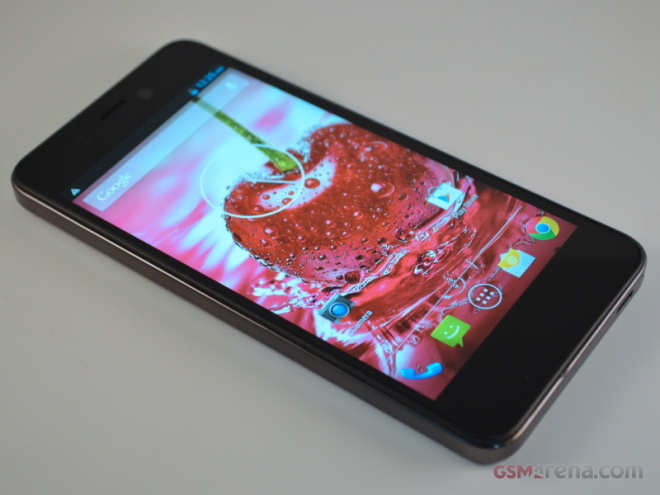Lava Iris Pro 30 review
Lava launched its new line of smartphones under the theme of “Art meets Smart” a few days ago. With the new venture the company has promised to deliver high-end smartphone experience at an affordable price tag.

The first smartphone in the new line up is the Iris Pro 30, which comes with a quad-core 1.2 GHz Cortex A7 CPU along with PowerVR SGX544 GPU on a MediTek MT6589 chipset.
Unboxing
The Lava Iris Pro 30 comes in a standard retail box, inside which you can find the A/C adapter, USB cable, headset and some paperwork.
Design
Lava’s latest smartphone looks a lot similar to the iPhone 5s, but the device is built using plastic with an aluminum frame running around the front panel. At 114 grams, the Iris Pro 30 is lighter than most of the smartphones out there, but that’s mostly due to the plastic used in the construction. The back cover is dust and fingerprint prone and we believe that the company could have used fancier material here.
On the front we have the display along with the three capacitive touch buttons – home, back and menu. The secondary camera and an array of sensors are located on the front of the device, while the power button and the voice rockers are placed in the right side of the smartphone. The 3.5mm audio jack has been designed on the top of the device and the USB port along with a noise cancellation microphone is paced at the bottom.
The back of the smartphone is where we get to see the 8 megapixel sensor with dual-LED flash and a tiny secondary microphone pinhole for noise cancellation. The speaker grille is at the bottom of the device. Underneath the back cover, there is a non-removable battery and three card slots – two for SIM cards and one for microSD card.
Display
Laval Iris Pro 30 sports a 4.7″ IPS LCD display that is produced by Sharp. The screen has a resolution of 720 x 1280 pixels and these numbers add up to a pixel density of 312 ppi, which is quite sharp by any standards.

The panel outputs 500 lumens of brightness and uses one glass solution that makes the assembly a lot thinner and thus contributing towards the overall weight reduction. The 720p display offers great colors and overall image quality. Viewing angles are pretty wide too.
User Interface
The Iris Pro 30 comes out of the box with Android 4.2.1 Jelly Bean OS and the user interface remains largely similar to the stock Android. The 1.2 GHz CPU along with 1 GB of RAM does as good as expected and the device runs pretty smoothly in day to day usage. However, we did encounter lag whenever we tried to multi-task.
Surprisingly, Lava’s newest flagship smartphone doesn’t carry any home-backed or third-party software goodies on-board and you will get to pick the apps you need from the Google Play Store, which is mostly good news. You may need to supply a few apps you would otherwise get preinstalled, but at least you won’t have to deal with unnecessary bloatware.
Having said that, there is one interesting widget on the notification menu that shows the usage of the CPU, battery, memory and the signal of your network in a graphical form.
Synthetic Benchmarks
We took the Lava Iris Pro 30 for a benchmark spin and stacked it up against some of its competition. We have already seen the performance of the Cortex A7 CPU, but has the company managed to get the most out of it? Well, let’s see.
We started with the single-core CPU performance test of the device with the help of the Benchmark Pi. As expected, the smartphone turned in a mediocre performance, scoring 372.
Benchmark Pi
- Samsung Galaxy S4 mini166
- HTC One X+280
- LG Optimus G285
- HTC One mini293
- Karbonn Titanium X298
- Samsung Galaxy Express346
- Lava Iris Pro 30372
- Xolo Q900388
- Sony Xperia M400
- Lenovo P780407
- Samsung Galaxy S II Plus409
- Sony Xperia L435
- Samsung Galaxy Young831
Next up, we aimed to test the overall performance of the smartphone with the AnTuTu benchmarking application. The results were disappointing considering the fact that other devices with the same processing unit managed to come up with better scores.
AnTuTu
Higher is better
- HTC One22678
- Sony Xperia Z20794
- Karbonn Titanium X15397
- Oppo Find 515167
- Samsung Galaxy S4 mini14518
- Lenovo P78013611
- Lava Iris Pro 3013502
- Xolo Q90013292
- Gigabyte GSmart Maya M1 v213216
- HTC Butterfly12631
- HTC One mini11434
- HTC Desire 600 dual sim11203
- Samsung Galaxy Xcover 26650
We then had the PowerVR SGX544 GPU jumping through hoops. The Epic Citadel test reveals that the company has probably opted for a lower clock graphics unit as the device failed to turn up a score as good as we expected.
Epic Citadel
Higher is better
- Samsung Galaxy S4 (Octa)59.8
- Karbonn Titanium X46.2
- Lenovo P78044.1
- Samsung Galaxy S III41.3
- Gigabyte GSmart Maya M1 v234.0
- Samsung Galaxy Core24.9
- Lava Iris Pro 3016
Lastly, we had the Vallamo test, which is used to measure the browsing performance of the device. This time a core of 1,476 points was about as good as we could expect.
Vellamo
Higher is better
- Sony Xperia SP2497
- Karbonn Titanium X1614
- HTC Desire 600 dual sim1572
- LG Optimus 4X HD1568
- Xolo Q9001563
- LG Optimus G1522
- Lava Iris Pro 301476
- Gigabyte GSmart Maya M1 v21471
- Lenovo P7801452
- Samsung Galaxy Core1366
- Nexus 41310
- Samsung Galaxy Fame1234
- Sony Xperia E dual1065
Camera
The camera of the Iris Pro 30 has a simple interface as seen in the previous Indian manufactured smartphones. The device is capable of shooting images in HDR, Panorama, Face beauty, multi angle view, smile shoot, best shot and EV bracket modes.
The settings menu offers three tabs – general, generic still and video capturing options. The first tab consist of Exposure, Color effect, White balance, Anti-flicker and image properties, while the other two tabs have controls for shutter delay, self-timer, microphone, EIS and many such features.
We also had the 8 megapixel camera in action and we were quite impressed with the overall image quality. The color rendering is quite accurate and the fine detail and dynamic range is quite good. There was some noise, but that is negligible considering the position of the device in the market. Overall, the rear shooter in the Lava Iris Pro 30 is a lot better than what the competition has got to offer.
Conclusion
Lava Iris Pro 30 is priced at $250 and is already available in the stores. The smartphone provides decent bang for your buck, combining a decent chipset with an unobtrusive UI. However, the company hasn’t quite managed to bring out the best of the MediaTek SoC, which is somewhat disappointing.
The display is quite sharp and we were surprised with the overall performance of its camera, especially considering what its competition has got to offer at a similar price tag.
However, the software is a big cause of concern as it comes with a fair share of bugs and has a negative effect on the overall performance of the device. Having said that, Lava can turn things around easily if it pulls out a few software upgrades and patches.
Pros
•Good Display
•Decent Camera
•Decent Camera
Cons
• Performance not as good as specs suggest
• Buggy software
• Buggy software





































No comments:
Post a Comment